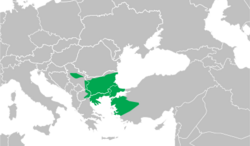Biology:Balkan crested newt
| Balkan crested newt | |
|---|---|

| |
| Museum specimen | |
| Scientific classification | |
| Domain: | Eukaryota |
| Kingdom: | Animalia |
| Phylum: | Chordata |
| Class: | Amphibia |
| Order: | Urodela |
| Family: | Salamandridae |
| Genus: | Triturus |
| Species: | T. ivanbureschi
|
| Binomial name | |
| Triturus ivanbureschi Arntzen & Wielstra, 2013
| |

| |
| Synonyms[2] | |
| |
The Balkan crested newt or Buresch's crested newt (Triturus ivanbureschi) is a newt species of the crested newt species complex in genus Triturus, found in Southeastern Europe and Anatolia.[3]
It was originally described as a subspecies of the southern crested newt, "Triturus karelinii arntzeni", in 1999,[4] and later considered a full species when genetic data showed it to be distinct.[5] After it was suggested the type specimen of "T. arntzeni" belonged in fact to the Macedonian crested newt (T. macedonicus), the species was redescribed, with a new type specimen, as T. ivanbureschi in 2013. The species epithet was chosen in honour of Bulgarian herpetologist Ivan Buresh.[3]
Its distribution ranges from the Southeastern Balkan peninsula (Western North Macedonia, Northwestern Greece, Bulgaria, Eastern Thrace) to Western Anatolia. An isolated population, surrounded by other crested newt species, occurs in Serbia.[3] Genetic data showed that Northern Anatolian populations east of the Bosphorus and Bursa form a separate, but morphologically indistinguishable sibling species, which was described as Anatolian crested newt (T. anatolicus) in 2016.[6]
The Balkan crested newt hybridises with the Anatolian crested newt at its eastern range end.[6] At the western and northern borders, it hybridises with the Macedonian crested newt, the Danube crested newt (T. dobrogicus), and the northern crested newt (T. cristatus).[7] The type specimen of "T. arntzeni" is in fact a hybrid between the Balkan and the Macedonian crested newt, so that this name is a synonym for both species.[8]
References
- ↑ Amphibian Specialist Group (2023). "Triturus ivanbureschi". IUCN Red List of Threatened Species 2023: e.T88103927A89695516. doi:10.2305/IUCN.UK.2023-1.RLTS.T88103927A89695516.en. https://www.iucnredlist.org/species/88103927/89695516. Retrieved 7 December 2024.
- ↑ Frost DR. (2015). "Triturus ivanbureschi. Amphibian Species of the World: an Online Reference. Version 6.0". New York, USA: American Museum of Natural History. http://research.amnh.org/vz/herpetology/amphibia/index.php//Amphibia/Caudata/Salamandridae/Pleurodelinae/Triturus/Triturus-ivanbureschi. Retrieved 2015-05-31.
- ↑ 3.0 3.1 3.2 Wielstra, B.; Litvinchuk, S. N.; Naumov, B.; Tzankov, N.; Arntzen, J. W. (2013). "A revised taxonomy of crested newts in the Triturus karelinii group (Amphibia: Caudata: Salamandridae), with the description of a new species". Zootaxa 3682 (3): 441–453. doi:10.11646/zootaxa.3682.3.5. ISSN 1175-5334. PMID 25243299.

- ↑ Litvinchuk, S.N.; Brokin, L.J.; Džukić, G.; Kalezić, M.L.; Khalturin, M.D.; Rosanov, J.M. (1999). "Taxonomic status of Triturus karelinii on the Balkans, with some comments about other crested newt taxa". Russian Journal of Herpetology 6 (2): 153–163. http://rjh.folium.ru/index.php/rjh/article/view/395.
- ↑ Espregueira Themudo, G.; Wielstra, B.; Arntzen, J.W. (2009). "Multiple nuclear and mitochondrial genes resolve the branching order of a rapid radiation of crested newts (Triturus, Salamandridae)". Molecular Phylogenetics and Evolution 52 (2): 321–328. doi:10.1016/j.ympev.2009.03.024. ISSN 1055-7903. PMID 19348957. Bibcode: 2009MolPE..52..321E.
- ↑ 6.0 6.1 Wielstra, B.; Arntzen, J.W. (2016). "Description of a new species of crested newt, previously subsumed in Triturus ivanbureschi (Amphibia: Caudata: Salamandridae)". Zootaxa 4109 (1): 73–80. doi:10.11646/zootaxa.4109.1.6. ISSN 1175-5334. PMID 27394852.

- ↑ Arntzen, J.W.; Wielstra, B.; Wallis, G.P. (2014). "The modality of nine Triturus newt hybrid zones assessed with nuclear, mitochondrial and morphological data". Biological Journal of the Linnean Society 113 (2): 604–622. doi:10.1111/bij.12358. ISSN 0024-4066.

- ↑ Wielstra, B.; Arntzen, J. W. (2014). "Kicking Triturus arntzeni when it's down: large-scale nuclear genetic data confirm that newts from the type locality are genetically admixed". Zootaxa 3802 (3): 381–8. doi:10.11646/zootaxa.3802.3.7. ISSN 1175-5334. PMID 24871018.

Template:Triturus-species Wikidata ☰ Q14447954 entry
 |


